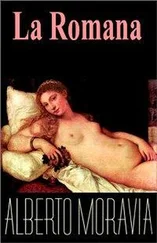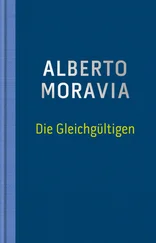Among the abandoned pages, a few (219*–220*, included in the appendix) suggest a different narrative direction. Instead of bumping into Maurizio and being invited to a party at his house, Sergio and Nella are invited to “a little gathering at the house of a man called Moroni, a friend, or more specifically a student, of Nella’s” (page 219*). As we know, this character and situation already appear in Version B, and it would seem that early on, Moravia intended to continue along those lines. Nella refuses to attend Moroni’s “little gathering” because of the poor state of her wardrobe, and Sergio becomes violent. The writer picks up this scene once again in Version C, but in reference to Maurizio’s party. One can therefore posit that these three pages were meant to follow the “prologue” (after page 249) and to constitute the first version of the party. The party will later become a gathering organized by Maurizio, and Moroni will become a guest, a small-time cinema producer.
II. EXTERNAL HISTORY
In order to reconstruct the external history of these typescripts, we must first gather all the information that can illuminate Moravia’s working process in the period between Il conformista ( The Conformist ), which he finished in November 1950 and published in April 1951 (see Opere , volume 3, pages 2972–82) and Il disprezzo ( Contempt ), which was begun, as we shall see, in July 1952 and published in 1954 (see Opere , volume 3, pages 2127–36). We will try to reconstruct, as far as the documents allow, the temporal arc spanning the period from the end of 1950 to the summer of 1952. We must consider the rare references in interviews and letters, even though, as we shall see, they are vague and contradictory.
THE INTERVIEWS
Two interviews are particularly relevant. Moravia was interviewed by Pasquale Festa Campanile on January 8, 1952, for the journal La Fiera Letteraria (The book fair) and one year later, on February 8, 1953, for the journal Il Lavoro Illustrato (Illustrated work). The first interview allows us some insight into the author’s literary and publishing situation during those years. Moravia says:
I have been suffering from insomnia. I work in the morning, and in the afternoon I rest. I’ve never been a very assiduous worker. It took me two years to finish Il conformista . I think it will take me some time to recover from this book. After all, I’ve written fifteen books. I’m preparing a volume of 600 pages for Bompiani, an anthology of stories […] all of the stories I have written from 1927 onward. I am currently writing a very modern play; I’d rather not say any more about it, perhaps I’ll never finish it. And besides, I don’t even know what the title will be, or how many acts it will have. On the other hand, I’ve been writing a lot of stories for the Corriere della sera . Have you seen them? They are all set in Rome. I am very attached to these stories; I’ve written fifty so far; I’m from Rome, I know it well, and I like its inhabitants. So I love to write about them in my own way […] I’ve been publishing these stories in the Corriere , and toward the end of the year I’m planning to gather them all into a volume. I think I will simply call it Racconti romani . I’ve also been thinking about a very short novel; but this is a project that I am not yet ready to discuss.
It seems that in early 1952 Moravia was mainly thinking about stories. The omnibus volume ( I racconti ) was in fact published in April 1952. Meanwhile, almost every month, Moravia published twenty more Roman tales in the Corriere , in addition to the fifty he had already published; they were all collected in a single volume in 1953. The reference to a project for the theater is more mysterious; it was probably abandoned. Even more mysterious and probably more relevant is the mention of a “very short novel,” which he is still “thinking about.” It seems that at this point early in 1952 Moravia had not yet begun work on the novel, and that he was still feeling tired and discouraged in the aftermath of Il conformista .
But a year later, in the 1953 interview, a different picture emerges. In the interviewer’s words:
Between 1950 and 1952, for example, [Moravia] wrote a long novel; he was not happy with it and decided to burn it. This novel recounted the story of a group of young Communists and the relationship between their romantic lives and their political ideologies. In other words, he wanted to show the degree to which a political party which does not allow space for individuality can influence the relations of the heart. The novel that Moravia is currently writing is entitled Fantasma di mezzogiorno; it too deals with a romantic episode. Fantasma di mezzogiorno is now finished, but Moravia is writing it again from the beginning, and he has not yet decided whether he will publish it.
Fantasma di mezzogiorno was the original title of Il disprezzo; in fact, the English edition was published under the title A Ghost at Noon . But the reference to a “long novel,” written between 1950 and 1952 and then incinerated, is a mystery. All we know is its subject (“the story of a group of young Communists and the relationship between their romantic lives and their political ideologies”) and the overriding idea (“the degree to which a political party which does not allow space for individuality can influence the relations of the heart”).
There are no other explicit references to this project in other interviews, unless we include a mention in the first autobiographical interview given by the author to Enzo Siciliano, published in 1971. The author recalls a sketch for an abandoned novel with a similar plot but dates it to the period after the publication of Il disprezzo and before La ciociara ( Two Women ); in other words, between 1954 and 1956:
Q: So, with La ciociara you returned to a Roman subject.
A: Yes. Well, if not a Roman subject, at least a choral theme, like the rest of my Roman writings. I had begun writing a very different novel: I had already written about two hundred pages, but I didn’t like them. It was the story of a very rich man who is responsible for the disillusionment of a young Communist because he manipulates him into going to bed with his wife, a very beautiful woman. Some time later I made a story out of it.
The plot sounds similar to the one regarding “a group of young Communists and the relationship between their romantic lives and their political ideologies,” or at least it seems to emerge from the same thematic intention. This sketch for a novel, which could be dated to the period 1954–1956, seems to be linked, like the one from the period 1950–1952, to the idea of the romantic life of a young Communist. Among the pages from the suitcase that appear to date from the period of La ciociara and La noia ( Boredom ), there are none that contain a similar plot featuring a Communist character (see Opere , volume 4), nor has a story with a similar subject been identified. This discrepancy could be explained simply by a lack of chronological precision on Moravia’s part during the interview, which took place twenty years after the fact. It is possible that in this interview Moravia was in fact referring to the project which he undertook in the period 1951–1952.
But we have no further details with which to support this hypothesis.
LETTERS
Leaving behind the contradictory references in his public declarations, we turn our attention to possible clues in Moravia’s private correspondence, especially the correspondence with his editor (see Opere , volume 3, pages 2063–2087 and 2126–2149). In this case too there are possible distortions, which may result from the fact that Moravia was attempting to obtain more advantageous conditions and financial assistance, especially during the years after the enormous success of La romana ( The Woman of Rome ), when he was seeking financial autonomy.
Читать дальше












